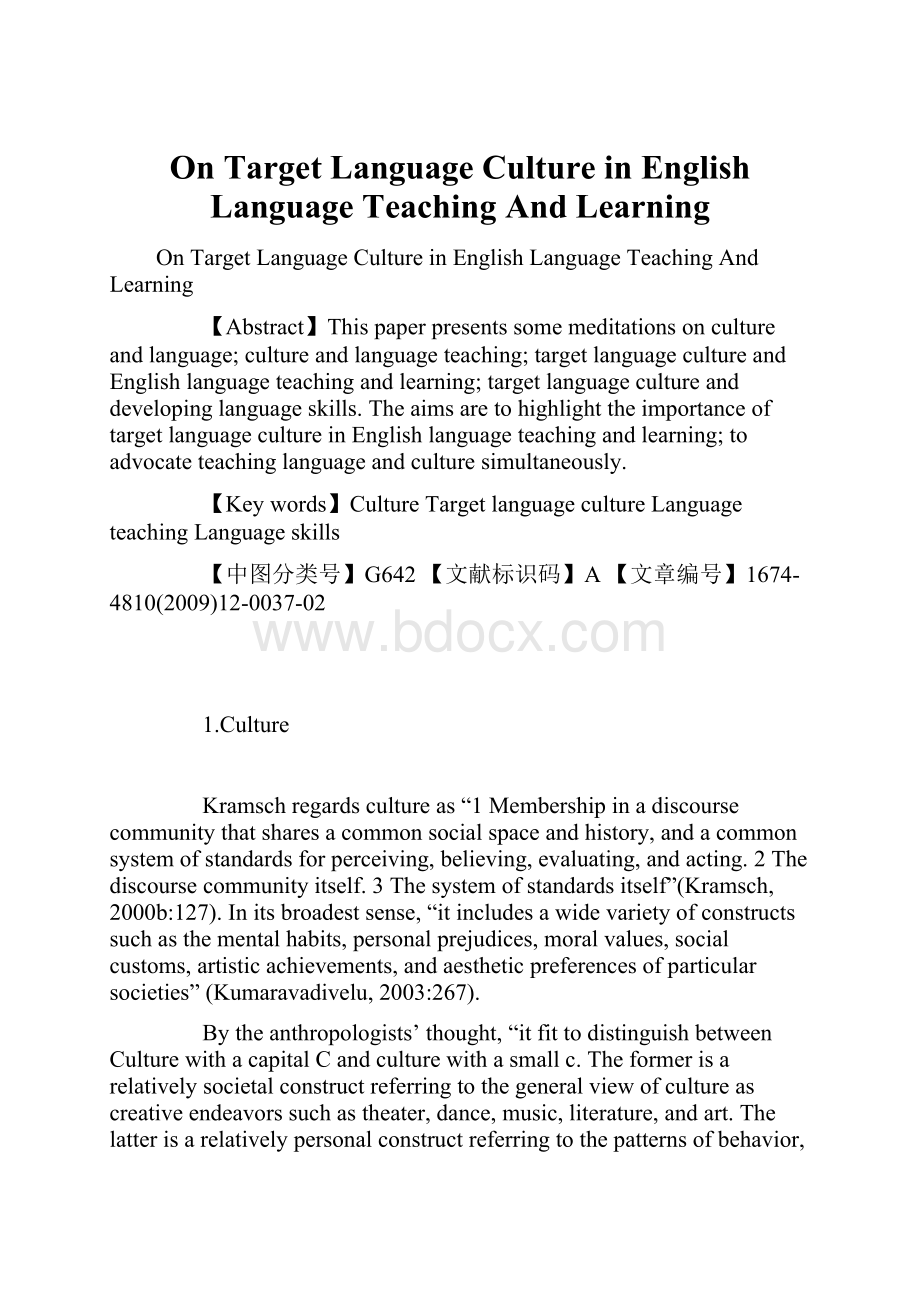 On Target Language Culture in English Language Teaching And Learning.docx
On Target Language Culture in English Language Teaching And Learning.docx
- 文档编号:25988166
- 上传时间:2023-06-17
- 格式:DOCX
- 页数:6
- 大小:18.37KB
On Target Language Culture in English Language Teaching And Learning.docx
《On Target Language Culture in English Language Teaching And Learning.docx》由会员分享,可在线阅读,更多相关《On Target Language Culture in English Language Teaching And Learning.docx(6页珍藏版)》请在冰豆网上搜索。

OnTargetLanguageCultureinEnglishLanguageTeachingAndLearning
OnTargetLanguageCultureinEnglishLanguageTeachingAndLearning
【Abstract】Thispaperpresentssomemeditationsoncultureandlanguage;cultureandlanguageteaching;targetlanguagecultureandEnglishlanguageteachingandlearning;targetlanguagecultureanddevelopinglanguageskills.TheaimsaretohighlighttheimportanceoftargetlanguagecultureinEnglishlanguageteachingandlearning;toadvocateteachinglanguageandculturesimultaneously.
【Keywords】CultureTargetlanguagecultureLanguageteachingLanguageskills
【中图分类号】G642【文献标识码】A【文章编号】1674-4810(2009)12-0037-02
1.Culture
Kramschregardscultureas“1Membershipinadiscoursecommunitythatsharesacommonsocialspaceandhistory,andacommonsystemofstandardsforperceiving,believing,evaluating,andacting.2Thediscoursecommunityitself.3Thesystemofstandardsitself”(Kramsch,2000b:
127).Initsbroadestsense,“itincludesawidevarietyofconstructssuchasthementalhabits,personalprejudices,moralvalues,socialcustoms,artisticachievements,andaestheticpreferencesofparticularsocieties”(Kumaravadivelu,2003:
267).
Bytheanthropologists’thought,“itfittodistinguishbetweenCulturewithacapitalCandculturewithasmallc.Theformerisarelativelysocietalconstructreferringtothegeneralviewofcultureascreativeendeavorssuchastheater,dance,music,literature,andart.Thelatterisarelativelypersonalconstructreferringtothepatternsofbehavior,values,andbeliefsthatguidetheeverydaylifeofanindividualoragroupofindividualswithaculturalcommunity”(Kumaravadivelu,2003:
267).
2.Meditationsonculture
Differentscholarsandexpertshavegotsuchdifferentviewsonculturethatculturehasbeendefinedinmanywaysbymanyscholarsrepresentingvariousdiscipline.AsKumaravadiveluargues,“cultureissuchacomplicatedconceptthatitdoesnotlenditselftoasingledefinitionorasimpledescription”(Kumaravadivelu,2003:
267).Butitisforme,fromtheperspectiveorspecialsphereoflanguageteaching,abetterdefinitionforcultureshouldbethecombinationofcapitalCandsmallc.
Accordingly,cultureisdefinedasaframeworktoourlives,somethingthataffectsourvalues,attitudesandbehavior.Ascultureissoinclusive,itactuallypermeateseveryaspectofhumanlifeandpredominantlyinfluencespeople’sbehaviorincludinglinguisticbehavior.Therefore,cultureisawidersystemthatcompletelyincludeslanguageasasubsystem.Actually,linguisticcompetenceisonevarietyofculturalcompetences,andspeechbehaviorisonevarietyofsocialbehavior.Therelationoflanguagetocultureisthatofparttowhole.
3.Cultureandlanguage
Itisextremelydifficulttoseparatelanguageandculture.Ontheonehand,languagebothexpressesandembodiesculturalreality.Firstofall,itexpressesfacts,ideas,orevents,whichrepresentsimilarworldknowledgebyitspeople,butalsopermeatespeople’sattitudes,beliefs,thewayofthinkingandviewingoftheworld.Besides,asasystemofsignswiththeirownculturalvalues,languagemaybeviewedasasymbolofsocialidentity.Forinstance,whenwelearnanewword,wetendtolookforitsmeaningintheworditself.Inadditiontoitsdictionarymeanings,thesamewordmaystirupdifferentassociationsinpeople.Peopleareidentifiedbyusingtheirlanguage.Inthissense,languagesymbolizesculturalreality.
AsBrownvividlydescribesthetwoasfollows:
“Alanguageisapartofacultureandacultureisapartofalanguage;thetwoareintricatelyinterwovensothatonecannotseparatethetwowithoutlosingthesignificanceofeitherlanguageorculture”(Brown,2000:
177).Inthisway,Icancomparetherelationshipbetweencultureandlanguagetotherelationoffishandwater:
languageisfish;cultureiswater.Withoutwaterfishwouldbedead.Similarly,withoutculture,languagewouldbemeaningless;withoutlanguage,culturewouldnotbeshaped.
4.Cultureandlanguageteaching
Languageisasocialphenomenonandatoolofcommunication,whichwasconventionalizedinthelonghistoryofsocialpracticeinasmuchaslanguagelearningisnotanisolatedprocess.Everylanguageisusedbyitspeopletoexpressthemselvesinspokenandwrittenformsincommunication.Meanwhile,apeople’slanguageisalwaysclosely-relatedtoitsreligion,history,cultureandsocialbackground.Cultureandlanguageareinseparableaslanguageisdeeplyrootedinculture.Languageandculturearecloselylinkedtoeachother.Languageknowledgeisapartofculturalknowledge.
Therefore,learningaforeignlanguageenablesyoutolearnitscultureandinturn,learningaboutanewcultureenablesyoutohaveadeepunderstandingofitslanguage.Kramschindicatesthatsecondandforeignlanguagelearnersnecessarilybecomelearnersofthesecondculturebecausealanguagecan’tbelearnedwithoutanunderstandingofthesecondculturalcontextinwhichitisused(Kramsch,2000a).Asanexample,whenIsaylunchintheUK,myclassmateswhohavewesternculturebackgroundsmaybereferringtohamburgerorpizzabutmyChineseclassmatesmaybereferringtostreamedbreadorrice.Itfollowsthatspecialattentionshouldbepaidtotheteachingofthetargetlanguage’sculture.
5.Targetcultureanddevelopinglanguageskills
IntheEnglishlanguageteachingcontext,despitegreateffortswithspeakingandlisteningpractices,itishardtoguaranteethatstudentswillnotcommitpragmaticerrorsandmistakesinactuallanguageuse.‘Fromasociolinguisticperspective,competenceinlanguageuseisdeterminednotonlybytheabilitytouselanguagewithgrammaticalaccuracy,butalsotouselanguageappropriatetoparticularcontexts.Thus,successfullanguagelearningrequireslanguageuserstoknowtheculturethatunderlieslanguage’(Tseng,2002:
12).ThisshowsthatwhenlearningtheEnglishlanguage,thestudentsshouldnotonlylearnitspronunciation,grammar,wordsandidiomsbutalsolearntheEnglish-speakingcountries’cultures,suchastheirideas,customs,andbehaviorofthesociety.
Indoingthis,studentscanenrichtheirknowledgeofthetargetlanguage’culture,fostertheirsensitivenesstothedifferentcultures,promotethelogicalthinkingability,andlayastrongbasementofdifferentcultures.Culturalknowledgeisanimportantpartofcommunicativecompetence.Improvingandemphasizingtheunderstandingofthetargetlanguage’scultureisoneoftheaimsofEnglishlanguagelearning.Actually,cultureasanelementwhichaffectsthedevelopinglanguageskillspermeatesthroughtheprocessoflanguagelearningandlanguageuse.
6.Targetcultureanddevelopingreadingskills
Inthefieldofreading,anarticleisasanentityandavehiclewhichconveysinformation.One’slanguageproficiencywillnotguaranteehimaneffectivereadingoutcomebecausereadingisaresultofaprocessofone’slanguageknowledge,culturalbackgrounds,andprofessionalknowledgewhichworkintegrally,andaprocessofpredictingandcorrectingbasedonone’slanguagecompetence,culturalknowledge,andlogicalabilityaswell.So,thelackingofculturalknowledgeofthetargetlanguagewillhaveanegativeeffectonstudents’languagelearningandunderstandingofthetextanddiscoursetheyarereading.
Asanexample,inmyformerteachingclass,whenreadingthissentence:
“ToVingoFloridawasinfacttheLandofPromise’thatappearedinCollegeEnglish(Intensivereading)Unit10/Book1,moststudentscouldnotunderstandthemeaningof‘theLandofPromise”.“TheLandofPromise’isanallusionquotedfromBible,whichmeansthelandGodpromisedtogivetotheIsraelites(Canaanites)andlaterthisallusionisusedasreferringto‘thelandofpromise”.Thisexampleshowsthatareade’sculturalbackgroundimpactsherabilitytounderstandtext’(TsengascitedinAndersonetall,1977)andthatdifficultiesandproblemsinreadingcannotbeovercomeandsolvedonlybylanguageknowledgebecauseapeople’sworksofliteraturereflectstheirculturalheritage.Thus,inteachingreading,teachersshouldteachlanguagepointsaswellasthetarget.
7.Targetcultureanddevelopingspeakingskills
SpeakingskillsareabigchallengewhichtheChinesestudentshavetofacebecausespeakingabilityisnotmerelytheproblemofdealingwithpronunciationandintonation.Peopletendtohavetheincorrectconceptionthatmasteringalanguagemeanshavingacommandofthebasicpartswhichalanguageconsistsof(grammar,word,idioms,pronunciationandintonation)andlanguageskills(listening,speaking,readingandwriting).Inourdailylife,languagecompetenceisthebaseofcommunicativecompetence.
So,ifteacherswanttheirstudentstohaverealcommunicativecompetence,theymustintroducethetargetlanguage’sculturetothestudents,and‘learnersmaynotonlyunderstandthemselvesbetter,butalsolearntheculturesofotherness,andevenaboutthetargetlanguageculture’(Tseng,2002:
16).Onlywhenstudentsareexposedtoaquantityoflanguagematerialsrelatedtothetargetlanguage’scultureandlearnedaboutthewesterncultureswilltheybeabletofacilitatetheirspeakingskillsandachievethegoalofcommunicationinthetargetlanguageproperly.Forexample,honestlyspeaking,IcouldnotusethefollowinggreetingsproperlybeforeIcametotheUK:
Howdoyoudo;Howareyou;Hello;Areyouallright;andAreyouOK.
8.Conclusion
Tosumup,theemphasisshouldbeputonteachingEnglishlanguageandtargetculturesimultaneously.IfweteachEnglishlanguageconnected
- 配套讲稿:
如PPT文件的首页显示word图标,表示该PPT已包含配套word讲稿。双击word图标可打开word文档。
- 特殊限制:
部分文档作品中含有的国旗、国徽等图片,仅作为作品整体效果示例展示,禁止商用。设计者仅对作品中独创性部分享有著作权。
- 关 键 词:
- On Target Language Culture in English Teaching And Learning
 冰豆网所有资源均是用户自行上传分享,仅供网友学习交流,未经上传用户书面授权,请勿作他用。
冰豆网所有资源均是用户自行上传分享,仅供网友学习交流,未经上传用户书面授权,请勿作他用。
链接地址:https://www.bdocx.com/doc/25988166.html


 《爱和自由》读书心得15篇.docx
《爱和自由》读书心得15篇.docx
![ISO-8501[1].1-2007-涂装表面清洁度的目视评定-(中文译本).doc](/Images/s.gif)